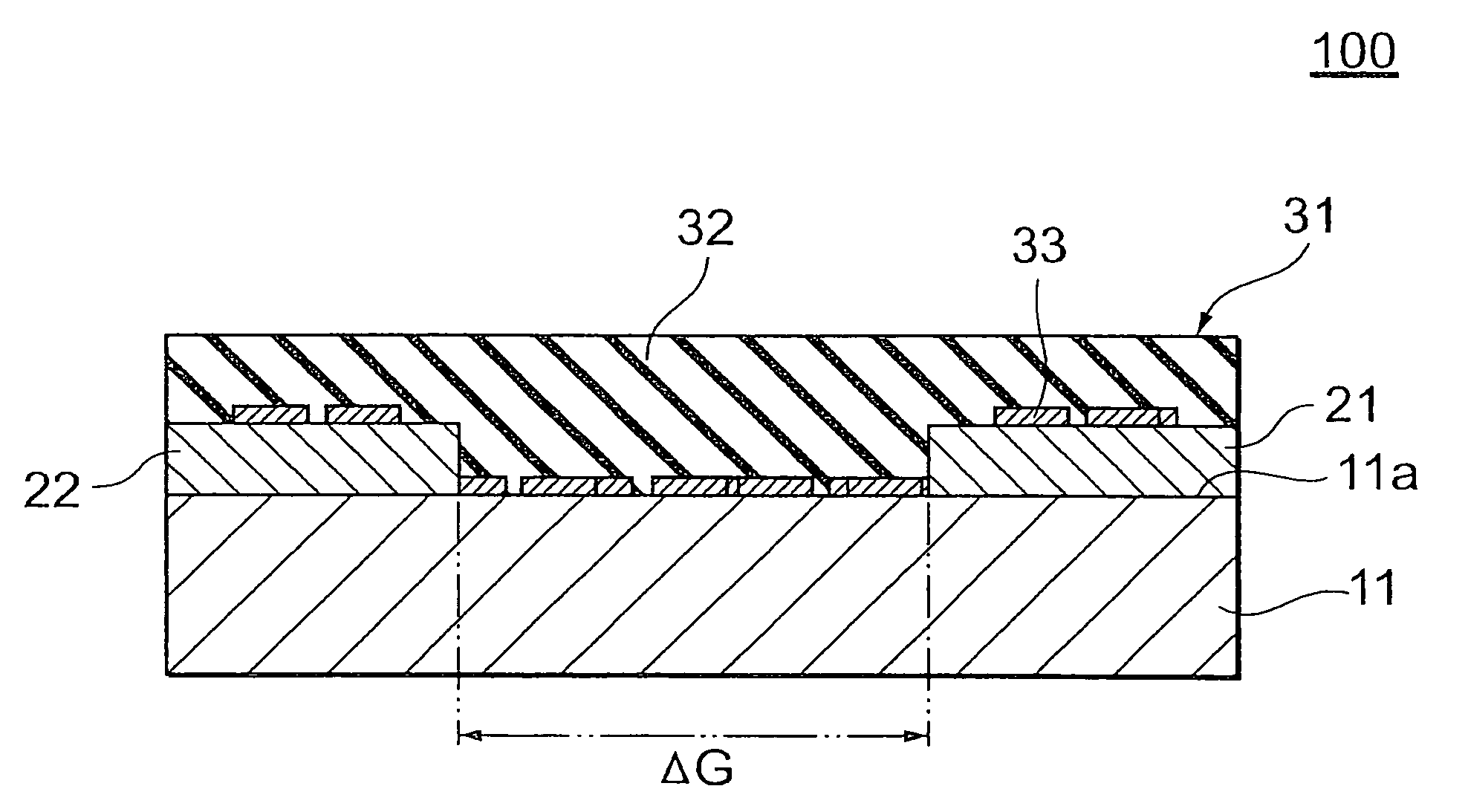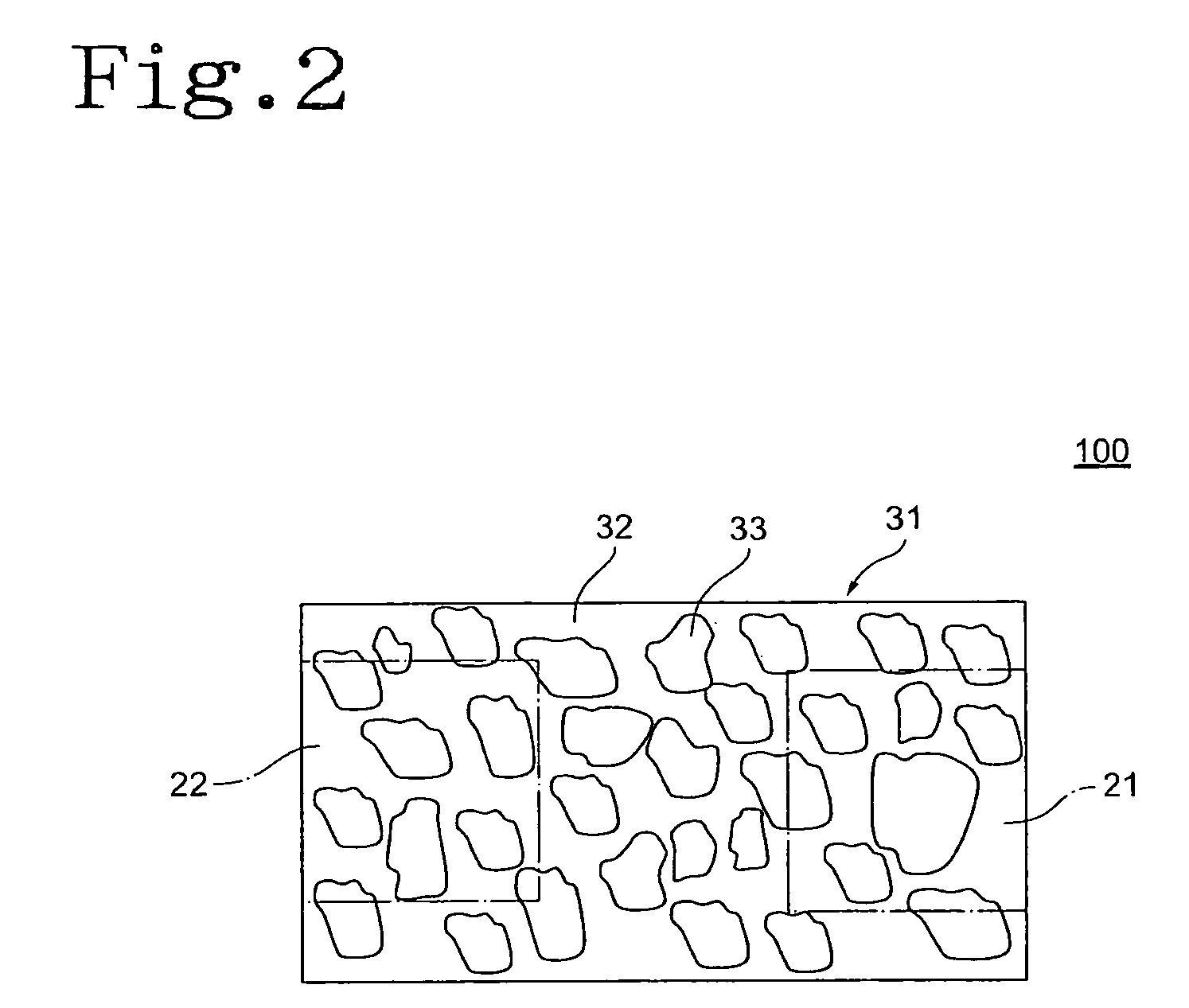ESD protection device
a protection device and esd technology, applied in the direction of semiconductor/solid-state device details, soldering apparatus, manufacturing tools, etc., can solve the problems of reduced signal quality, poor heat resistance of formed organic-inorganic composite films, and tendency to change film characteristics, so as to improve productivity and cost effectiveness, reduce the effect of siz
- Summary
- Abstract
- Description
- Claims
- Application Information
AI Technical Summary
Benefits of technology
Problems solved by technology
Method used
Image
Examples
first embodiment
[0030]FIG. 1 is a diagrammatic cross-sectional view schematically showing a first embodiment of an ESD protection device according to the present invention. An ESD protection device 100 includes an insulating substrate 11, a pair of electrodes 21 and 22 disposed on the insulating substrate 11, a functional layer 31 disposed between the electrodes 21 and 22, and terminal electrodes 41 (see FIG. 6) electrically connected to the electrodes 21 and 22. The ESD protection device 100 is designed to allow the functional layer 31 to function as a low-voltage discharge-type electrostatic protection material and ensure initial discharge between the electrodes 21 and 22 through the functional layer 31 when an overvoltage, such as static electricity, is applied.
[0031]The insulating substrate 11 has an insulating surface 11a. The dimensions and shape of the insulating substrate 11 are not particularly limited to any specific ones provided that the substrate can support at least the electrodes 21 ...
second embodiment
[0043]FIG. 3 is a diagrammatic cross-sectional view schematically showing a second embodiment of the ESD protection device according to the present invention. An ESD protection device 200 has the same configuration as that of the ESD protection device 100 of the first embodiment described above except that the functional layer 31 is replaced with a functional layer 51.
[0044]The functional layer 51 is a composite in which the conductive inorganic material 33 (not shown) is discretely dispersed in the matrix of the insulating inorganic material 32 (not shown). In the present embodiment, the functional layer 51 is formed by sputtering a target containing the insulating inorganic material 32 (or simultaneously sputtering a target containing the insulating inorganic material 32 and a target containing the conductive inorganic material 33) on the insulating surface 11a of the insulating substrate 11 and / or on the electrodes 21 and 22 and then applying a voltage between the electrodes 21 a...
example 1
[0048]First, sputtering was used to form a metallic thin film made of Cu and having a thickness of 100 nm nearly all over the insulating surface 11a, which is one surface of the insulating substrate 11 (an NiZn ferrite substrate having a dielectric constant of 13 manufactured by TDK Corporation), as shown in FIG. 4. Photolithography was then used to etch the thus formed Cu thin film so as to form a pair of strip-shaped electrodes 21 and 22 facing but spaced apart from each other. The gap distance ΔG between the electrodes 21 and 22 was 3 μm.
[0049]Thereafter, sputtering was used to form the functional layer 31 on the insulating substrate 11 and on the electrodes 21 and 22 in the following procedure, as shown in FIG. 5:
[0050]First, sputtering was used to form an Au film on parts of the surface of the insulating substrate 11 on which the electrodes 21 and 22 were formed. As a result, a layer of the conductive inorganic material 33 in which the island-shaped Au thin films having a thick...
PUM
| Property | Measurement | Unit |
|---|---|---|
| thickness | aaaaa | aaaaa |
| frequency | aaaaa | aaaaa |
| resistivity | aaaaa | aaaaa |
Abstract
Description
Claims
Application Information
 Login to View More
Login to View More - R&D
- Intellectual Property
- Life Sciences
- Materials
- Tech Scout
- Unparalleled Data Quality
- Higher Quality Content
- 60% Fewer Hallucinations
Browse by: Latest US Patents, China's latest patents, Technical Efficacy Thesaurus, Application Domain, Technology Topic, Popular Technical Reports.
© 2025 PatSnap. All rights reserved.Legal|Privacy policy|Modern Slavery Act Transparency Statement|Sitemap|About US| Contact US: help@patsnap.com



